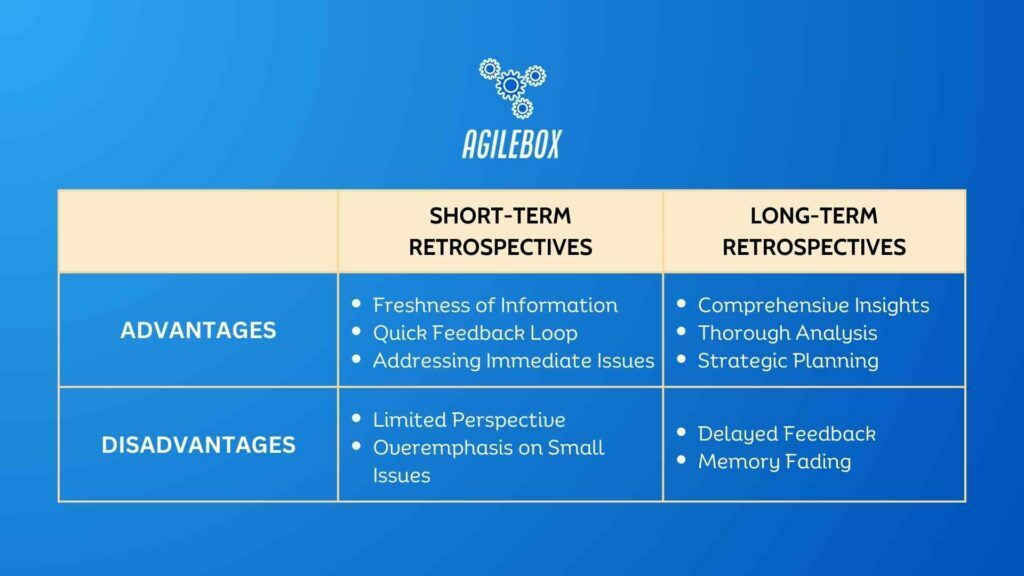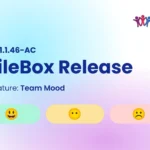Contents
I. Introduction
A. Explanation of Retrospectives
Retrospectives are an essential part of agile project management, especially in Scrum. They are structured meetings at the end of each iteration or project phase where the team reflects on its processes and performance. The main goal is to identify what went well, what could be improved, and how to implement those improvements in future iterations.
Retrospectives can vary in duration and frequency, typically categorized as long-term or short-term. Short-term retrospectives often occur at the end of every sprint or iteration, usually lasting a few weeks. In contrast, long-term retrospectives may occur after several months or at the end of a project.
B. Importance of Continuous Improvement
Continuous improvement is a cornerstone principle in agile methodologies. It is about constantly seeking ways to improve products, services, or processes. In project management, this can mean improving efficiency, reducing waste, enhancing product quality, or increasing customer satisfaction.
Retrospectives play a vital role in facilitating continuous improvement. By reflecting on past actions and outcomes, teams can learn from their experiences, make necessary adjustments, and plan for future success. Continuous improvement is not a one-time effort but a perpetual cycle of examining, learning, and enhancing.
C. Purpose of this article
This paper explores the benefits and drawbacks of long-term and short-term retrospectives and their impact on continuous improvement. Both approaches offer unique advantages and challenges, influencing the pace and depth of learning and adaptation. By comparing these two methodologies, the paper aims to provide insights into their suitability in different project environments, guiding professionals to make informed decisions in their retrospective practices.
II. Short-Term Retrospectives
A. Definition and Purpose
Short-term retrospectives refer to frequent and regular review meetings conducted at shorter intervals, such as at the end of each iteration or sprint within an agile framework. These are usually held every few weeks and aim to inspect the recent work, analyze what went well and what didn’t, and adapt the plan and processes accordingly for the next iteration. The primary purpose is to provide a mechanism for continuous, incremental improvement on a near real-time basis.
B. Advantages
1. Freshness of Information:
Since short-term retrospectives happen frequently, the events and experiences under discussion remain fresh in the participants’ minds. This facilitates more accurate recall and nuanced understanding, enabling a more honest and practical assessment.
2. Quick Feedback Loop:
The short interval between retrospectives creates a rapid feedback loop, allowing teams to identify and implement improvements quickly. This agility can lead to higher efficiency and responsiveness to changing circumstances or customer needs.
3. Addressing Immediate Issues:
Short-term retrospectives enable teams to pinpoint and address immediate challenges and issues by focusing on the recent past. This can lead to quicker resolutions, fostering a more adaptive and resilient development process.
C. Disadvantages
1. Limited Perspective:
The narrow time frame of short-term retrospectives can sometimes cause a limited perspective. The team might overlook long-term trends, patterns, or strategic concerns by concentrating solely on immediate past events. This lack of a broader view might impede the identification of underlying systemic issues.
2. Overemphasis on Small Issues:
With regular and frequent meetings, there might be an overemphasis on trivial or immediate issues, while more significant, underlying problems remain unaddressed. This focus on the ‘trees’ rather than the ‘forest’ can result in misaligned priorities and missed opportunities for more profound improvement.

III. Long-Term Retrospectives
A. Definition and Purpose
Long-term retrospectives are reflective meetings over extended intervals, such as quarterly, annually, or after significant project phases. Unlike their short-term counterparts, long-term retrospectives focus on capturing trends, patterns, and broader insights that might not be apparent in a shorter time frame. They aim to provide a comprehensive understanding of the project’s evolution, challenges, and successes and support strategic planning and alignment with long-term goals.
B. Advantages
1. Comprehensive Insights:
By examining a broader period, long-term retrospectives can capture complex trends and patterns that might be missed in a more short-term view. This holistic perspective can lead to more informed decisions and strategies that align with the organization’s long-term objectives.
2. Thorough Analysis:
Long-term retrospectives offer an opportunity for more in-depth and meticulous analysis. Teams can delve into the root causes of issues and explore systemic problems that may not be evident in a narrow time frame. This deeper understanding can lead to more meaningful and sustainable improvements.
3. Strategic Planning:
Aligned with organizational goals and future planning, long-term retrospectives provide a platform for strategic discussions and long-term goal setting. This alignment ensures that the team’s efforts are not only focused on immediate gains but also contribute to the broader vision and mission of the organization.
C. Disadvantages
1. Delayed Feedback:
The extended interval between retrospectives can delay identifying and addressing issues. This slower feedback loop might hinder the team’s ability to adapt quickly to emerging challenges, potentially affecting the project’s overall success.
2. Memory Fading:
As time passes, the details and nuances of specific events or experiences may fade from the participants’ memories. This loss of information can reduce the accuracy and effectiveness of the retrospective, leading to potential misunderstandings or missed opportunities for learning and improvement.
IV. Comparing the Two Approaches

A. Factors Affecting the Decision
The decision to conduct long-term or short-term retrospectives is not one-size-fits-all; several variables should be considered:
1. Project or Team Nature:
Different projects or teams might have different needs and objectives influencing the most suitable retrospective interval. Fast-paced, dynamic projects may benefit from short-term retrospectives, while more complex and long-term endeavors might require a long-term perspective to uncover deeper insights.
2. Team Size and Composition:
Large teams or those with varied skill sets and responsibilities may necessitate more frequent retrospectives to ensure alignment and address immediate challenges. Conversely, smaller or more homogenous teams may find value in less frequent but more strategic reflections.
3. Industry or Domain:
Specific industries or domains like software development may naturally align with short-term retrospectives due to rapid changes and iterative cycles. Others, like manufacturing or healthcare, might benefit more from a long-term view considering broader trends and regulatory landscapes.
B. Balancing Short-Term and Long-Term Perspectives
In many cases, the most effective approach may not be choosing between short-term and long-term retrospectives but integrating both perspectives:
1. Combining Retrospective Intervals:
By incorporating both short-term and long-term retrospectives, teams can maintain a continuous improvement mindset while also keeping an eye on strategic objectives and long-term trends. This combination can provide a more nuanced and holistic view of the project’s progress and challenges.
2. Alternating Intervals:
Teams may also consider rotating between short-term and long-term retrospectives based on project phases, milestones, or specific goals. Alternating intervals allow for immediate responsiveness and adaptation while ensuring that the team’s efforts align with broader organizational strategies and visions.
V. Best Practices for Long-Term and Short-Term Retrospectives
A. Short-Term Retrospective Best Practices
When conducting short-term retrospectives, certain practices can enhance effectiveness:
1. Effective Facilitation:
Active participation and open communication are crucial to uncovering real issues and opportunities for improvement. Facilitators should encourage team members to share their thoughts and feelings without judgment, fostering a safe environment where everyone feels comfortable speaking freely.
2. Prioritization:
Given the frequent nature of short-term retrospectives, focusing on actionable items with significant impact is essential. Prioritizing key areas ensures the team is not overwhelmed and can make tangible improvements within the next iteration.
B. Long-Term Retrospective Best Practices
For long-term retrospectives, some best practices might include:
1. Data Collection and Analysis:
With a broader time frame under consideration, utilizing quantitative and qualitative data can provide insights into patterns, trends, and underlying issues. Analyzing this data methodically helps form an objective assessment of long-term performance and helps make informed decisions.
2. Involving Stakeholders:
Long-term retrospectives often relate to strategic goals and broad organizational objectives. Engaging relevant stakeholders, such as executives, customers, or other departments, can gather diverse perspectives and enrich the analysis. This inclusive approach ensures that the retrospective is aligned with the larger ecosystem in which the project or team operates.
VI. Conclusion
Long-term and short-term retrospectives each have their place in different organizational contexts, and understanding when to use one over the other, or how to combine them, is a critical skill. This comprehensive examination underscores the multifaceted nature of retrospectives and the importance of nuanced approaches that align with specific needs and objectives.
Above all, it emphasizes that retrospectives are not merely procedural activities but essential cultural practices that enable organizations to thrive in an ever-changing landscape. By recognizing and harnessing the strengths and weaknesses of both approaches, teams, and organizations can create a resilient, responsive, and continually evolving environment that fosters success and fulfillment.
AgileBox is a Jira app that helps teams plan, collaborate, and track their agile projects. This is a powerful tool that can help teams improve their agile development process, which is developed by DevSamurai team. AgileBox makes the Agile process seamless, simple, fun, colorful, and productive.
This toolbox is for Agile teams to estimate, and prioritize the product backlog, conduct retrospectives, daily standup & team health analysis, with three main features: Planning Poker for Jira, Agile Retrospective for Jira, and Daily Standup for Jira.
Try out our app now: Agile Planning Poker, Retrospectives, Daily Standup for Jira













